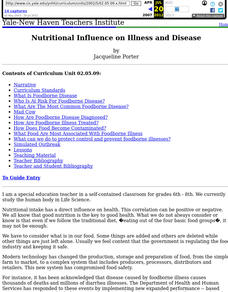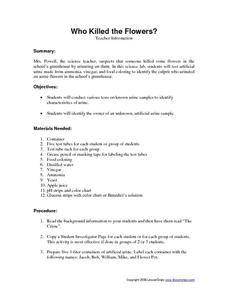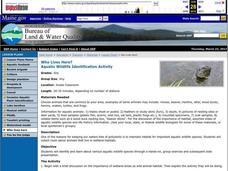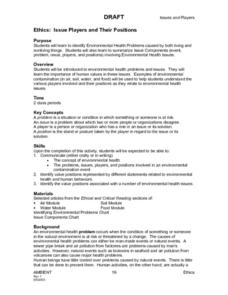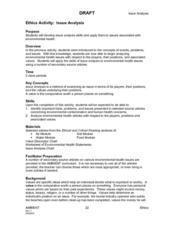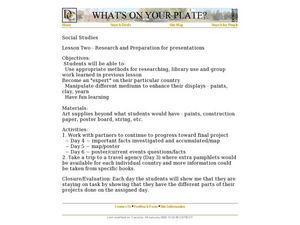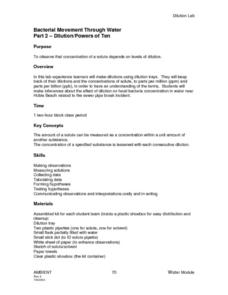Curated OER
Nutritional Influence on Illness and Disease
Students examine nutritionally related diseases and illnesses, evaluating studies and developing topics for a science fair project. They investigate bacteria, researching how it can be harmful or helpful, and create illustrated displays.
Lesson Snips
Who Killed the Flowers?
This could be really good, or it could be really bad! The crime to be solved is, "Who went pee in the flowerpot?" Given four imitation urine samples, young chemists or crime scene investigators perform pH, glucose, and turbidity...
Curated OER
Habitat Awareness
Second graders build a habitat. In this wildlife activity, 2nd graders work in groups to build a mammals habitat. They share their habitat with the class.
Curated OER
Who Lives Here?
Learners identify various aquatic wildlife species. In this biology instructional activity students collect clues about animals that live in wetland habitats. Learners rotate through several stations displaying particular animal species...
Curated OER
Observation and Stimulation of bioluminescence and chemiluminescence
Students are introduced to chemical reactions, reaction rates, chemiluminescence, fluorescence and bioluminescence. They use glow sticks are used to demonstrate the effect of temperature on the rates of chemical reactions. Pupils recall...
Curated OER
Molecular Movement in Water Part 1- Diffusion
Students obseve and compare molecular movement within water at various temperatures and of varying salinity. They discuss the movement of water on a larger scale which can affect the movement and concentrations of microbial populations...
Curated OER
Issue Players and Their Positions
Students identify Environmental Health Problems caused by both living and nonliving things. They summarize Issue Components (event, problem, issue, players, and positions) involving environmental health issues such as contamination in...
Curated OER
Filter-Feeding in Reef Sponges
Students make observations and describe the filter-feeding in sponges as it relates to the ecological role of sponges on coral reefs. In this filter-feeding in reef sponges instructional activity, students are introduced to the feeding...
Curated OER
Ethics Activity: Issue Analysis
Learners analyze environmental health issues with respect to the players, their positions, and associated values, after being introduced to the concepts of events, problems, and issues. They apply the skills of issue analysis to...
Curated OER
Dietary Supplements and the Chemistry of Life
Students study the effects of dietary supplements on bodily functions. In this health lesson students calculate their caloric needs and research dietary supplements.
Curated OER
Children's Literature Across the Curriculum Ideas: The Magic School Bus Plants Seeds
Students read The Magic School Bus Plants Seeds by Janna Cole. They complete a variety of cross-curricular activities surrounding the study of plants and seeds. Included are reading, art, math, science, writing, social studies, and...
Curated OER
Nutrition in Me!
Third graders explain the basic healthy eating and physical activity concepts. In this healthy lifestyles instructional activity, 3rd graders describe two main components of a healthy lifestyle, demonstrate two different types of...
Curated OER
A Healthy Start To Every Day
Students discuss the importance of having a healthy breakfast to begin their day. Students develop a cause and effect relationship between breakfast and their overall well being. They work cooperatively to plan balanced breakfast menus.
Curated OER
Generate a Calibration Curve for Chlorophyll a
Young scholars measure and graph the absorbance of light by chlorophyll at a specific wavelength versus chlorophyll concentration. They are given an unknown and determine its concentration from their calibration curve. Students become...
Curated OER
Obtain a visible spectra of chlorophyll a
High schoolers become familiar with the concept of spectroscopy or the study of the interaction of matter with electromagnetic radiation. They prepare solutions and measure absorbance at different wavelengths. Pupils comprehend that...
Curated OER
Must We Shoot Bambi?
Students explore the deer population. In this environmental lesson, students participate in a hands-on activity to better understand the concept of controlling the deer population.
Curated OER
Children's Literature Across the Curriculum Ideas-Ira Sleeps Over
Students read Ira Sleeps Over by Bernard Waber. They complete a variety of cross-curricular activities surrounding the ideas presented in the story. Included are reading, art, math, science, writing, social studies, and library...
Teacher Vision
The First Thanksgiving - Pilgrim Study Unit
Students explain the origins of Thanksgiving. As a class, they list all the meanings, stories, and images that come into their minds when they hear the word "Thanksgiving." After reading about Thanksgiving, pairs of students create 4...
Curated OER
What's on Your Plate? Lesson 2
Students research countries of the world. In this global studies instructional activity, students discover details of cultures in the world as they become experts on selected countries. Students create posters and brochures that feature...
Curated OER
Your Own Fresh Water Aquarium in the Classroom
Learners explore aquariums. In this fish and ecosystems lessons, students establish a freshwater aquarium environment using materials provided. Learners read about and care for the classroom fish.
Curated OER
Snug in the Snow
Students explore how snow helps animals survive in the wild. In this animal science lesson plan, students review key vocabulary words and discuss types of animal adaptations. Students construct shoebox to simulate the snowy environment...
Curated OER
Bacterial Movement Through Water Part 2- Dilution/Powers of Ten
Students make dilutions using dulution trays. They keep track of their dilutions and the concentrations of solute, to parts per million (ppm) and parts per billion (ppb), in order to have an comprehension of the terms. Students make...
Curated OER
LIONS and TIGERS and BEARS. . .Oh My! Animals of Connecticut and the World
Students identify and list the different types of pets owned by the children in the class.
They graph the total number of each type of pet owned. They draw or cut-out a picture of an animal. Using the materials listed above, the children...
Curated OER
Testing for Life
Students test for organic molecules to determine if a solution contains once living molecules. In this characteristics of life lesson plan, students test common liquids for the presence of organic molecules, including starch, protein,...
